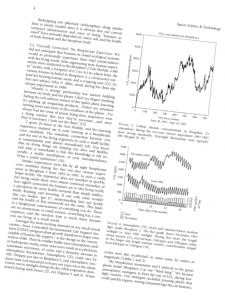Space: Science & Technology
Volume 2021 | Article ID 8067539 | DOI
by Mark Nelson, Biospherian (1991-93)
Abstract
 Biosphere 2, the largest and most biodiverse closed ecological system facility yet created, has contributed vital lessons for living with our planetary biosphere and for long-term habitation in space. From the space life support perspective, Biosphere 2 contrasted with previous BLSS work by including areas based on Earth wilderness biomes in addition to its provision for human life support and by using a soil-based intensive agricultural system producing a complete human diet. No previous BLSS system had included domestic farm animals. All human and domestic animal wastes were also recycled and returned to the crop soils. Biosphere 2 was important as a first step towards learning how to miniaturize natural ecosystems and develop technological support systems compatible with life.
Biosphere 2, the largest and most biodiverse closed ecological system facility yet created, has contributed vital lessons for living with our planetary biosphere and for long-term habitation in space. From the space life support perspective, Biosphere 2 contrasted with previous BLSS work by including areas based on Earth wilderness biomes in addition to its provision for human life support and by using a soil-based intensive agricultural system producing a complete human diet. No previous BLSS system had included domestic farm animals. All human and domestic animal wastes were also recycled and returned to the crop soils. Biosphere 2 was important as a first step towards learning how to miniaturize natural ecosystems and develop technological support systems compatible with life.
Biosphere 2’s mostly successful operation for three years (1991-1994) changed thinking among space life support scientists and the public at large about the need for minibiospheres for long-term habitation in space. As an Earth systems laboratory, Biosphere 2 was one of the first attempts to make ecology an experimental science at a scale relevant to planetary issues such as climate change, regenerative agriculture, nutrient and water recycling, loss of biodiversity, and understanding of the roles wilderness biomes play in the Earth’s biosphere. Biosphere 2 aroused controversy because of narrow definitions and expectations of how science is to be conducted.
The cooperation between engineers and ecologists and the requirement to design a technosphere that supported the life inside without harming it have enormous relevance to what is required in our global home. Applications of bioregenerative life support systems for near-term space applications such as initial Moon and/or Mars bases, will be severely limited by high costs of transport to space and so will rely on lighter weight, hydroponic systems of growing plants which will focus first on water and air regeneration and gradually increase its production of food required by astronauts or inhabitants. The conversion of these systems to more robust and sustainable systems will require advanced technologies, e.g., to capture sunlight for plant growth or process usable materials from the lunar or Martian atmosphere and regolith, leading to greater utilization of in situ space resources and less on transport from Earth.
There are many approaches to the accomplishment of space life support. Significant progress has been made especially by two research efforts in China and the MELiSSA project of the European Space Agency. These approaches use cybernetic controls and the integration of intensive modules to accomplish food production, waste treatment and recycling, atmospheric regeneration, and in some systems, high-protein production from insects and larvae. Biosphere 2 employed a mix of ecological self-organization and human intervention to protect biodiversity for wilderness biomes with a tighter management of food crops in its agriculture. Biosphere 2’s aims were different than bioregenerative life support systems (BLSS) which have focused exclusively on human life support.
Much more needs to be learned from both smaller, efficient ground-based BLSS for nearer-term habitation and from minibiospheric systems for long-term space application to transform humanity and Earth-life into truly multiplanet species.

